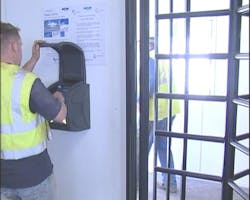Schlage biometric readers secure access to London Olympic sites for five years
Dublin, Ireland, Jan. 16, 2013 – Allegion PLC (NYSE: ALLE), a leading global provider of security products and solutions, today announced that its Schlage biometric hand readers were used at the Olympic Park construction site in London, enrolled 81,000 people and handled over 30 million transactions, throughout the five year build program.
Human Recognition Systems (Liverpool) developed and installed the system which uses Schlage HandPunch readers in tandem with smart cards and their own Biometrics Information Management System, which integrates biometrics with management software programs to let construction managers perform a variety of functions that address concerns regarding health and safety details, accreditation, site access and report generation.
“Because of its low false reject rate, hand geometry is especially practical in high throughput applications,” explains Paul Taylor, UK sales leader for Electronic Access Control (EAC) solutions at Allegion. “In a construction environment in which hands and fingers take a beating, the readers are unaffected because they are evaluating a three-dimensional reading of the hand’s shape.”
To maintain adequate security levels, access to construction sites historically has been granted using a card-based system. Security officers would verify the credentials of each employee against his card and make a manual entry into the register. This process meant that gaining access to the construction site was a laborious process and unsupervised. Access using smart cards often allowed workers to clock in and out for each other.
With such a large number of stakeholders, it would have been difficult for project managers to control access to the many sites, know who is onsite and if they had the necessary credentials to be there. As a consequence, there was a potential of site security being compromised, unnecessary overhead due to litigation costs on health and safety violations, buddy punching and incorrect payments to contractors.
Instead, access to London’s Olympic venues was granted by verifying the credentials of employees against their biometric hand geometry templates. Upon hiring, the worker was enrolled into the system by inserting his hand onto the platen of the HandPunch reader and being provided with his own individual PIN number. Then, to enter the work site, the construction worker simply entered his own PIN number on the keyboard of the Schlage HandPunch reader and then placed his hand on the reader’s platen. If the hand matched the template from the system, the worker was allowed entry. Each transaction was recorded by the system and provided project managers with accurate information on the number of workers onsite, duration of stay and other information.
Accreditation was tied to employee biometric details and featured an inbuilt alarm to warn managers of those about to reach expiry date. When an employee was banned from a site, this change cascaded to every site networked with the central solution. Managers could also store details in the system whenever an employee was involved in an accident.
The use of biometrics has grown with each successive Olympic Games. From protecting athletes at the 1984 Games, the use of hand geometry readers has been a feature of access control at Olympic Games since. By the time the 1996 Games ended, hand geometry tracked 65,000 people, providing over 1 million transactions in 28 days. That Olympics was the first wide-scale deployment of ID cards linked to hand geometry readers through radio frequencies. Each card contained a chip that stored an ID number and a digital template of the person's hand to whom the badge was issued. As a person approached high-security access points, such as those into the Olympic Village, the radio-frequency chip transmitted the image and number. A computer recorded the number so that a person's entry and exit could be tracked.
Meanwhile, the person placed her hand on a hand geometry reader that took and compared a three-dimensional geometric image of the hand with the image sent by the ID card. Access was denied unless the two matched. The entire process took only a few seconds.


